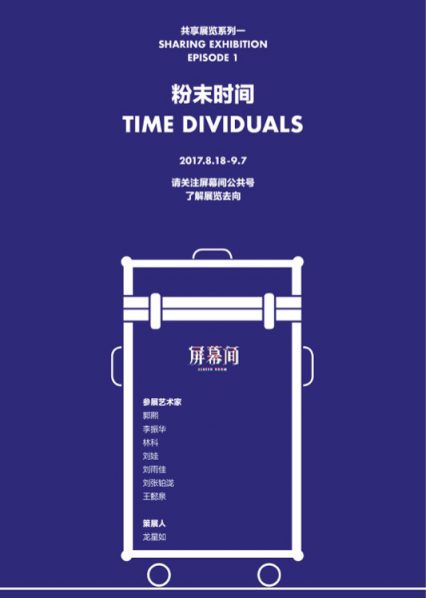
In response to the “sharing economy” in China, the Sharing Exhibition series proposes a production process with “shared” curators and artists, and exhibits at “shared” spaces for “shared” audiences. The target audience of the exhibition is dilettantes, part-time art lovers, occasional and “by-the-way” art aficionados. In their creative process, curators and artists follow the methodologies of knowledge sharing platforms and only work for this exhibition in their idle time, mining their idle knowledge base.
The exhibition takes the form of a portable digital screen on which seven artists’ works are displayed. The screen arrives at its hosts via courier services. The hosts will follow a guidebook which breaks down a traditional exhibition setting procedure in a lightweight fashion: “exhibition setup” (putting the screen on the wall), “opening reception” (asking friends for a party), “symposium” (having at least one participant), and “press coverage” (posting on social media sites). The exhibition tours in private spaces within a timeframe of five weeks.
SHARING EXHIBITION EPISODE I
TIME DIVIDUALS
In a New York Times blog, Sergey Brin, co-founder of Google, replied to a text message (“what’s up”) with an image of his lunch, taken via his Google Glass. To reply to text with an image may have been poetic and subtle in the past, but there is no such ambiguity today. Photographs have become “communicative”, to reference scholar of photography and American art Robin Kelsey.
A four-year-old company, Instagram, is roaring along the electronic superhighway and generating a unique visual culture: “gaze”, “representation”, and “retrospection” have faded into the background. The image is not just metaphorical and symbolic, but itself readable material, even more direct than language. In China, the biggest social media platform, WeChat, is also creating a world of short videos; 10 seconds in length, entitled “sights”. Approximately 20 words can be spoken in 10 seconds, and this time storage is collapsing into images and videos that exist ephemerally only on mobile devices – or perhaps, in philosopher Bernard Stiegler’s words, being carried away by the “flow”.
If the Tower of Babel is to collapse once again today, perhaps God will notice that verbal language is no longer the tool to separate humans; the barrier of mother tongues seems to not prevent global comprehension of images on social media. “Seeing comes before words” might have iterated into “seeing is words”. Video clips of mere seconds in length are not normally considered video art, but they are nevertheless how we perceive the world: ten seconds of the first snow, ten seconds of a live concert, or ten seconds of a natural disaster. With the birth of the “digital native” generation to whom “techno-ethics” is far less of an issue, discussion on the visual culture of super short videos becomes worth investigating. Time fragments, or “dividuals”, construct miscellaneous life moments that can be treated as documentation, narration or commentary. They also pervade our brain sulci, delivering carnivals or morbid fantasies.
In Time Dividuals they invite artists to confront the ephemera of visuals and react with imaginaries no longer than thirty seconds.
Curator: Iris Xingru Long
About Screen Room
The Screen Room project aims to feature artists who use the screen as an interface or medium to explore the boundaries of creativity and imagination in a daily-life context, and to trigger further conversations. Screen Room researches and experiments with screen-based artistic creation and exhibiting, making interventions into people’s daily reading and interacting with various screens, as well as exploring the production and communication of art in the age of screen.
About the exhibition
Dates: Aug 18, 2017 – Sep 7, 2017
Opening: Aug 18, 2017, Friday, 5:00pm
Venue: please refer to Screen Room's public account to see the latest venue
Opening Reception: Vice Beijing
Artists: Guo Xi, Li Zhenhua, Lin Ke, Liu Zhangbolong, Liu Wa, Liu Yujia, Wang Yiquan
Courtesy of the curator.




























